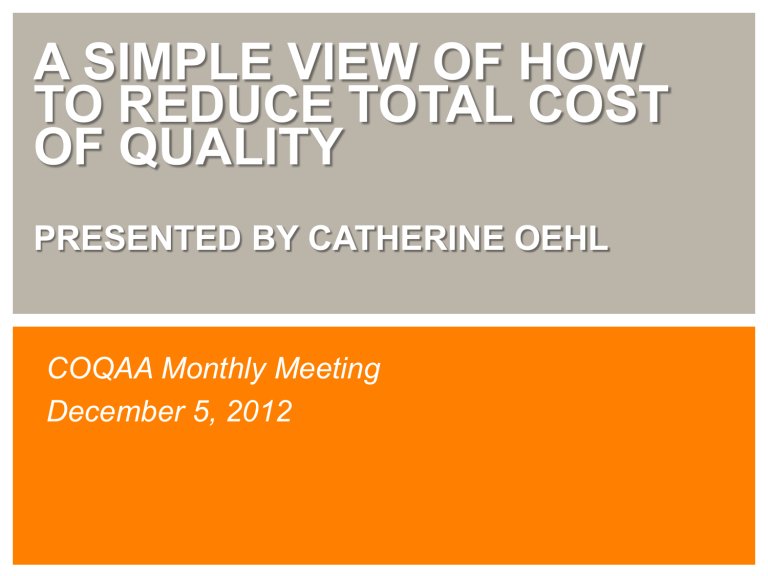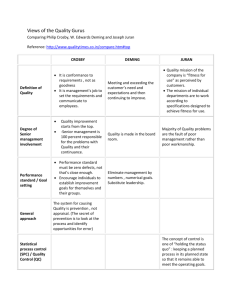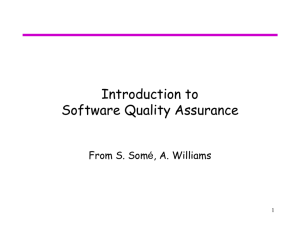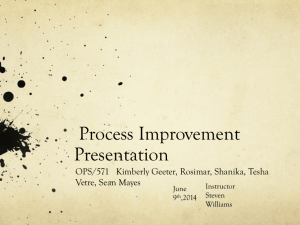to the presentation ()

A SIMPLE VIEW OF HOW
TO REDUCE TOTAL COST
OF QUALITY
PRESENTED BY CATHERINE OEHL
COQAA Monthly Meeting
December 5, 2012
AGENDA
• What is Quality and Why is it important
• What is Total Cost of Quality (TCoQ)
• What is the purpose and value of measuring TCoQ
• How to measure and reduce TCoQ
• Hypothetical Scenario applying TCoQ
• Q&A
12/5/2012 2
QUALITY DEFINED
• Definition: A measure of excellence or a state of being free from defects, deficiencies and significant variations. It is brought about by strict and consistent commitment to certain standards that achieve uniformity of a product in order to satisfy specific customer or user requirements.
• ISO 8402-1986 standard defines quality as "the totality of features and characteristics of a product or service that bears its ability to satisfy stated or implied needs."
• If an automobile company finds a defect in one of their cars and makes a product recall, customer reliability and therefore production will decrease because trust will be lost in the car's quality.
Source: http://www.businessdictionary.com/definition/quality.html
12/5/2012 3
CONSEQUENCES OF POOR
QUALITY
12/5/2012 4
COMMON STATE OF QUALITY
o Current projects spend 40-50% of the effort on avoidable rework o About 80% of avoidable rework comes from 20% of the defects o About 80% of defects comes from 20% of the modules and about half of the modules are defects free o 90% of the downtime comes from at most 10% of the defects o Peer Reviews catch 60% of the defects o Perspective-based reviews catch 35% more defects than non directed reviews o Disciplined personal practices can reduce defect introduction rates by up to 75% o While several organizations measure and track application total cost of ownership (TCO), very few measure the total cost of quality
12/5/2012 5
WHAT IS TCOQ
• Total Cost of Quality (TCoQ) consists of the costs associated with preventing, assessing, finding and correcting defective work.
• Note that the TCoQ analysis looks only at our
(producers) costs and not the customer’s cost due to poor quality.
12/5/2012 6
QUALITY COSTS OF TCOQ
Prevention cost + Inspection cost + Internal Failure cost + External Failure cost
Prevention costs arise from efforts to keep errors or defects from occurring at all
Inspection costs arise from detecting errors/defects via inspections, tests, audits
Internal failure costs arise from defects caught internally and dealt with by discarding or repairing the defective items
External failure costs arise from defects that actually reach customers. Often other costs are incurred in addition to correcting the failure.
12/5/2012 7
PURPOSE AND VALUE OF TCOQ
Addresses and measures the following questions:
• What is the state of quality of your applications?
• How does quality impact your business?
• How is quality measured?
• When are errors/defects introduced? Why?
• When are errors/defects corrected? What are the costs?
• What are the processes that impact quality?
• How do you quantify the effectiveness of each process?
• How much do failures cost?
• What is the root cause of the failure?
12/5/2012 8
WHEN AND WHERE ARE
DEFECTS INTRODUCED
Requirements
56%
Design
27%
Unknown
Coding
7%
10%
Source: Writing Testable Requirements, Dick Bender
12/5/2012
Source: NIST Software Quality Study
9
WHEN AND WHERE ARE
DEFECTS DETECTED
Source: NIST Software Quality Study
10 12/5/2012
COST TO CORRECT DEFECTS
Source: B. Boehm and V. Basili, “Software Defect Reduction Top 10 List”, IEEE Computer
12/5/2012 11
THE QUALITY LEVER
Prevention /
Reviews
Appraisal /
Inspection
Failures /
Reaction
Greatest
Leverage
Good
Leverage
Least
Leverage
Source: http://en.wikipedia.org/wiki/Quality_costs
12/5/2012
Cost Savings
12
PREVENTIVE COSTS
GOAL: Prevent defects before they happen
(Work done right the first time)
Recommended Activities:
– Formal Requirements Gathering Processes
– Requirements Analysis and Management
– Early Prototyping
– Usability Analysis
– Static Testing
– Peer Reviews
– Release and Configuration Management Processes
– Standards for Test Environments
– Quality Training
– Accurate Internal Communication
12/5/2012 13
INSPECTION COSTS
GOAL: Detect the Errors (Find them early)
Recommended Activities:
– Code inspections
– Design reviews
– Glass box and black box testing
– Test Automation
– Usability Testing
– Pre-release / User Acceptance Testing
– Structured Personal reviews focused on verification and validation
12/05/2012 14
INTERNAL FAILURE COSTS
GOAL: Report and fix defects before production release (Fix and Re-Test)
Incurred Activities:
• Diagnose Defects
• Defect Fixes
• Defect Management
• Re-Test and Regression Testing
• Rework code and recompile
• Wait states
12/5/2012 15
EXTERNAL FAILURE COSTS
GOAL: Reduce and remediate impact to customers
(Apologize and recover)
Incurred Activities:
• Technical Support Calls
• Recalls
• Customer Service
• Scrap
• Overtime
• Regulatory / Legal Costs
12/5/2012 16
HYPOTHETICAL SCENARIO
• Suppose we have a software product that has one production release per quarter.
• On average each release contains 1000 must-fix defects that will be identified and repaired.
• We will assume developers catch 25% of defects during unit and integration testing at a cost of $10/defect
12/5/2012 17
1 - NO INSPECTION TESTING
Non Formal
Testing Inspection Testing Costs
Staff
Infrastructure
Tools
Total Investment
$0
$0
$0
$0
Development
Must-Fix Defects Found
Fix Cost (Internal Failure - $10/defect)
Testing (Pre-Release)
Must-Fix Defects Found
Fix Cost (Internal Failure - $100/defect)
250
$2,500
0
$0
Customer Support (Production)
Must-Fix Defects Reported
Fix Cost (External Failure - $1000/defect)
Cost of Quality
Conformance (Inspection Costs)
NonConformance (Internal Failures + External
Failures)
TCoQ
ROI
12/5/2012
750
$750,000
$0
$752,500
$752,500
N/A
18
2 - MANUAL INSPECTION
TESTING
Inspection Testing Costs
Staff
Infrastructure
Tools
Total Investment
Non Formal
Testing
$0
Manual
Testing
$60,000
$0
$0
$0
$10,000
$0
$70,000
Development
Must-Fix Defects Found
Fix Cost (Internal Failure - $10/defect)
Testing (Pre-Release)
Must-Fix Defects Found
Fix Cost (Internal Failure - $100/defect)
250
$2,500
0
$0
250
$2,500
350
$35,000
Customer Support (Production)
Must-Fix Defects Reported
Fix Cost (External Failure - $1000/defect)
Cost of Quality
Conformance (Inspection Costs)
NonConformance (Internal Failures + External
Failures)
TCoQ
ROI
12/5/2012
750
$750,000
$0
$752,500
$752,500
N/A
400
$400,000
$70,000
$437,500
$507,500
350%
19
3 - MANUAL WITH AUTOMATED
INSPECTION TESTING
Inspection Testing Costs
Staff
Infrastructure
Tools
Total Investment
Development
Must-Fix Defects Found
Fix Cost (Internal Failure - $10/defect)
Testing (Pre-Release)
Must-Fix Defects Found
Fix Cost (Internal Failure - $100/defect)
Non Formal
Testing
$0
$0
Manual
Testing
$60,000
$10,000
Automated
Testing
$60,000
$10,000
$0
$0
$0
$70,000
$12,500
$82,500
250
$2,500
0
$0
250
$2,500
350
$35,000
250
$2,500
500
$50,000
What if we added some simple
Prevention activities like
Static Reviews,
Peer Reviews,
Change
Management ?
Customer Support (Production)
Must-Fix Defects Reported
Fix Cost (External Failure - $1000/defect)
Cost of Quality
Conformance (Inspection Costs)
NonConformance (Internal Failures +
External Failures)
TCoQ
ROI
12/5/2012
750 400
$750,000 $400,000
$0 $70,000
$752,500 $437,500
$752,500 $507,500
N/A 350%
250
$250,000
$82,500
$302,500
$385,000
445%
20
4 - ADDING PREVENTION
ACTIVITIES
Prevention Costs
Static Reviews (10 people every 2 weeks reviewing 5 sets of documents x $75/hr)
Peer Reviews (2 developers every 2 weeks reviewing 10 modules x $75)
Change Management (10% Configuration Mgr & 10% Requirements Lead & 10% Test Lead)
Inspection Testing Costs
Staff
Infrastructure
Tools
Total Investment (Prevention & Inspection costs)
Development
Must-Fix Defects Found
Fix Cost (Internal Failure - $10/defect)
Testing (Pre-Release)
Must-Fix Defects Found
Fix Cost (Internal Failure - $100/defect)
Customer Support (Production)
Must-Fix Defects Reported
Fix Cost (External Failure - $1000/defect)
Cost of Quality
Conformance (Inspection Costs)
NonConformance (Internal Failures + External Failures)
TCoQ
ROI
Non Formal Testing Manual Testing Automated Testing
$0 $60,000 $60,000
$0
$0
$0
$10,000
$0
$70,000
$10,000
$12,500
$82,500
250
$2,500
0
$0
750
$750,000
$0
$752,500
$752,500
N/A
250
$2,500
350
$35,000
400
$400,000
$70,000
$437,500
$507,500
350%
250
$2,500
500
$50,000
250
$250,000
$82,500
$302,500
$385,000
445%
Resource Costs
$97,500
$39,000
$46,800
$265,800
500
$5,000
350
$35,000
50
$50,000
$265,800
$90,000
$355,800
57%
12/5/2012 21
SUMMARY
• Quality creates value and reduces risk exposure
• The “cost of quality” isn’t the price of creating a quality product or service. It’s the cost of NOT creating a quality product or service.
• Errors / defects are often introduced early and typically found later
• Total Cost of Quality (TCoQ) consists of the costs associated with preventing, assessing, finding and correcting defective work.
• The central theme of quality improvement is that larger investments in prevention drive even larger savings in quality-related failures and
Inspection efforts.
• Any Quality improvement effort should use TCoQ to quantify the effectiveness of the process.
12/5/2012 22
CONTACT INFO AND Q&A
Catherine Oehl oehlc@yahoo.com
614-440-6477
LinkedIn Profile: http://lnkd.in/u8kcyy
12/5/2012 23
RESOURCES & REFERENCES
Software Defect Reduction Top 10 List by Barry Boehm and Victor Basili
Using Cost Benefit Analysis to Develop Software Process Improvement
Strategies, Data Analysis Center of Software
Traditional P-A-F method by Juran (1951) and Feigenbaum (1956) –
Prevention Appraisal and Failure costs
Phil Crosby’s Model from the book Quality is Free (1979) – conformance to requirements – cost of conformance (done Right) and non-conformance
(done Wrong)
Process Cost Model by Ross (1977)
http://asq.org/learn-about-quality/cost-of-quality/overview/overview.html
http://www.authorstream.com/Presentation/Hassanasif-493959-cost-ofquality
http://www.bexcellence.org/Cost-Of-Quality.html
http://www.isixsigma.com/implementation/financial-analysis/cost-quality-notonly-failure-costs/
http://www.projectconnections.com/articles/051005-koch.html
12/5/2012 24
SUGGESTED TCOQ BENCHMARK
MEASUREMENTS
• Process (Productivity & Prevention)
– Effectiveness of Test Processes
• Release Mgt, Configuration Mgt
– Efficiency of Test Processes
• Defect Mgt, Test Environment Mgt, Test Data Mgt
– Consistency of Test Activities
• Test Planning, Test Estimation, Test Execution
• Schedule
– Testing Planning
• Duration of lifecycle phases
• Duration of Test Phase/Stage
– Test Estimating/Projections
• Planning Estimate
• Component Based Estimates
12/5/2012 25
COMMON MEASUREMENTS OF
FAILURES
• Failures
– Volume of Defects
• Open, Closed, New, Test Phase/Stage Contained,
Defect Aging (# of days open)
– Severity of Defects
• Criticals, Highs, Mediums, Lows, Problem Areas,
Low to all reported ratio
12/5/2012 26
SIMPLE ACTUAL QUALITY COSTS
• Build Test Mgt Costs (P+I+IF)
– Manual Test Hour Costs
– Automated Test Hour Costs
– Test Hour Costs per Test Phase/Stage
– % of Total Build Costs
• Breakfix/Maintenance Costs (EF)
12/5/2012 27
VIEW OF TCOQ IN TERMS OF QA
12/5/2012 28







